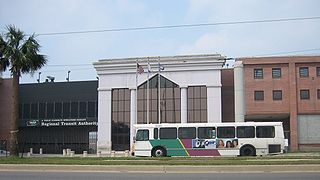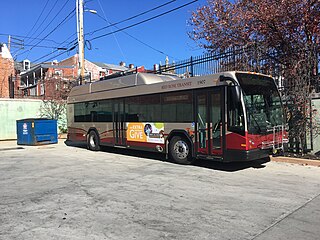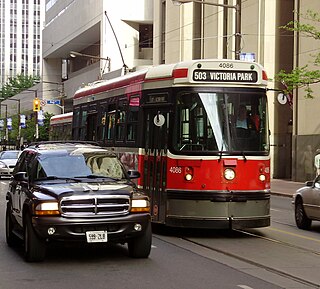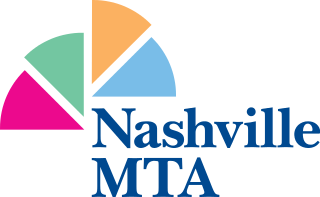Related Research Articles

The New Orleans Regional Transit Authority is a public transportation agency based in New Orleans. The agency was established by the Louisiana State Legislature in 1979, and has operated bus and historic streetcar service throughout the city since 1983. In 2022, the system had a ridership of 7,244,700, or about 36,800 per weekday as of the first quarter of 2023, making the Regional Transit Authority the largest public transit agency in the state of Louisiana.
The Metropolitan Transit Authority of Harris County is a major public transportation agency based in Houston, Texas, United States. It operates bus, light rail, bus rapid transit, HOV and HOT lanes, and paratransit service in the city as well as most of Harris County. It also operates bus service to two cities in Fort Bend County, and to Conroe in Montgomery County. The Metro headquarters are in the Lee P. Brown Administration Building in Downtown Houston. In 2022, the system had a ridership of 60,121,300, or about 211,400 per weekday as of the first quarter of 2023.

Miami-Dade Transit (MDT) is the primary public transit authority of Miami, Florida and the greater Miami-Dade County area. It is the largest transit system in Florida and the 15th-largest transit system in the United States. As of 2022, the system has 60,734,900 rides per year, or about 254,400 per weekday in the first quarter of 2023. MDT operates the Metrobus with their paratransit STS systems run by LSF. MDT also operates two rail transit systems: Metrorail and Metromover.

Metromover is a free mass transit automated people mover train system operated by Miami-Dade Transit in Miami, Florida, United States. Metromover serves the Downtown Miami, Brickell, Park West and Arts & Entertainment District neighborhoods. Metromover connects directly with Metrorail at Government Center and Brickell stations. It also connects to Metrobus with dedicated bus loops at Government Center and Adrienne Arsht Center station. It originally began service to the Downtown/Inner Loop on April 17, 1986, and was later expanded with the Omni and Brickell Loop extensions on May 26, 1994.
Metro Transit is the primary public transportation operator in the Minneapolis–Saint Paul area of the U.S. state of Minnesota and the largest operator in the state. Although Metro Transit is one of the smallest transit systems for a large metropolitan area in the United States, it has previously been ranked as one of the best. In 2022, the system had a ridership of 38,794,700, or about 123,900 per weekday as of the first quarter of 2023.

The Greater Cleveland Regional Transit Authority is the public transit agency for Cleveland, Ohio, United States and the surrounding suburbs of Cuyahoga County. RTA is the largest transit agency in Ohio, with a ridership of 19,104,900, or about 67,300 per weekday as of the first quarter of 2023.

The Hamilton Street Railway commonly known as the HSR is a public transport agency in Hamilton, Ontario, Canada. The name is a legacy of the company's early period, when public transit in Hamilton was primarily served by streetcars. Although streetcars are no longer used in the city today, the HSR operates bus and paratransit services, with a ridership of 21 million passengers a year. The HSR uses the Presto card as its method of fare payment, allowing for connections with GO Transit and other transit systems in the Greater Toronto area.

Spokane Transit Authority, more commonly Spokane Transit or STA, is the public transport authority of central Spokane County, Washington, United States, serving Spokane, Washington, and its surrounding urban areas. In 2022, the system had a ridership of 6,995,300, or about 28,900 per weekday as of the first quarter of 2023.

The Ann Arbor Area Transportation Authority (AAATA), branded as TheRide, is the public transit system serving the Ann Arbor and Ypsilanti area in the U.S. state of Michigan. In fiscal year 2021, the system had a ridership of 1,725,797.

The Red Rose Transit Authority (RRTA) is a transit agency serving Lancaster County, Pennsylvania. RRTA is headquartered in downtown Lancaster. The South Central Transit Authority owns RRTA and the Berks Area Regional Transportation Authority (BARTA). In 2022, the system had a ridership of 1,240,200, or about 4,900 per weekday as of the first quarter of 2023.

The 503 Kingston Rd is an east–west Toronto streetcar route in Ontario, Canada, operated by the Toronto Transit Commission. The 503 Kingston Rd travels on a route to the downtown financial district from the Bingham Loop along Kingston Road and shares much of its track with the 501 Queen and 504 King. Originally a rush-hour service, the route was upgraded in September 2019 to run weekdays excluding evenings after the consolidation of 502 Downtowner service into this route. Effective July 30, 2023, route 503 started running all day and all evening, seven days per week.

The Nashville Metropolitan Transit Authority, which does business as WeGo Public Transit, is a public transportation agency based in Nashville, Tennessee. Consisting of city buses and paratransit, the system serves Nashville and Davidson County. Most bus routes serve the downtown transit station, Music City Central. This makes the MTA the largest transit agency where most of the bus routes terminate in a central business district with no crosstown service. In 2022, the system had a ridership of 7,344,400, or about 25,700 per weekday as of the first quarter of 2023. For 2023, the Nashville MTA expected to collect $5.2 million in fare revenue and to spend $99.3 million in operation. To make up most of the difference, MTA expected to collect subsidies from the city, state, and national governments.

The Metro Orange Line is a bus rapid transit line in the Twin Cities, Minnesota operated by Metro Transit. The line operates primarily along Interstate 35W from downtown Minneapolis through Richfield and Bloomington before terminating in Burnsville, Minnesota. The Orange Line provides access to 198,000 jobs with roughly a quarter of them outside downtown Minneapolis. The route serves a mix of stations located in the center of the highway, stations near highway exits, and on-street stations. The line has features typical of bus rapid transit systems with off-board fare payment, articulated buses with extra doors, stations with improved passenger amenities, and transit-only bus lanes on portions of the route.

The St. Cloud Metropolitan Transit Commission, branded as Metro Bus, is the primary provider of mass transportation in St. Cloud, Minnesota. Service is provided daily using a fleet of 37 full-sized buses. The agency was formed in 1969 after the private St. Cloud Bus Lines began to cut routes and increase fares, leading the Minnesota State Legislature to establish a Transit Authority to make up for perceived inadequate service.
Maritime Metro Transit is the public transportation system in Manitowoc, Wisconsin. It is owned and operated by the city of Manitowoc.
Galesburg Transit is the primary provider of mass transportation in Knox County, Illinois with routes serving the Galesburg area. As of 2019, the system provided 160,712 rides over 23,487 annual vehicle revenue hours with 4 buses and 8 demand response vehicles.
South Central Illinois Mass Transit District is a provider of mass transportation in Clinton, Franklin, Jefferson, Marion, Perry and Washington counties in Illinois, with deviated fixed-routes serving numerous cities, as well as demand-response service across the counties. As of 2021, the system provided 60,311 rides over 14,109 annual vehicle revenue hours.

Butler County Regional Transit Authority, also stylized as BCRTA, is the primary provider of mass transportation in Butler County, Ohio with twelve routes serving the region. As of 2019, the system provided 620,233 rides over 70,789 annual vehicle revenue hours with 18 buses and 17 paratransit vehicles.
GO bg Transit is a provider of mass transportation in Bowling Green, Kentucky with five routes serving the region. The service, operated by RATP Dev USA, is one of two transit operations in Bowling Green, the other being WKU's Topper Transit. As of 2019, the system provided 99,954 rides over 23,084 annual vehicle revenue hours with 8 buses and 9 paratransit vehicles.
Marion Transit System (MTS) is the primary provider of mass transportation in Marion, Indiana with five routes serving the region. As of 2019, the system provided 257,760 rides over 14,708 annual vehicle revenue hours with 5 buses and 1 paratransit vehicle.
References
- ↑ "People Supporting Transit System". The Leaf-Chronicle. December 1, 1987. Retrieved September 8, 2023.
- ↑ "Clarksville Transit System Agency Profile" (PDF). Retrieved September 2, 2023.
- ↑ "Transit Systems in Tennessee" . Retrieved September 2, 2023.
- ↑ "Clarksville Transit System announces Nashville State students ride Free". Clarksville Online. March 24, 2021. Retrieved September 2, 2023.
- ↑ "Clarksville Transit System announces route information now available on Google". Clarksville Online. September 8, 2021. Retrieved September 2, 2023.
- ↑ "Clarksville Transit System announces Mobile Tickets are now an option for Transit Riders". Clarksville Online. December 29, 2021. Retrieved September 2, 2023.
- ↑ "Clarksville Transit System to cancel Route 1000". Clarksville Online. January 25, 2022. Retrieved September 2, 2023.
- ↑ "Routes" . Retrieved September 2, 2023.
- ↑ "Transit Guide" . Retrieved September 2, 2023.
- ↑ Terry Hollahan (April 4, 1992). "Ceremony Officially Opens City Bus Transfer Station". The Leaf-Chronicle. Retrieved September 8, 2023.
- ↑ Jimmy Settle (January 31, 1991). "Low Bidder for Station Claims Error". The Leaf-Chronicle. Retrieved September 8, 2023.
- ↑ "CTS seeks input on downtown transit center relocation". Leaf Chronicle. October 29, 2021. Retrieved September 8, 2023.
- ↑ "The National Transit Database (NTD)" . Retrieved September 2, 2023.